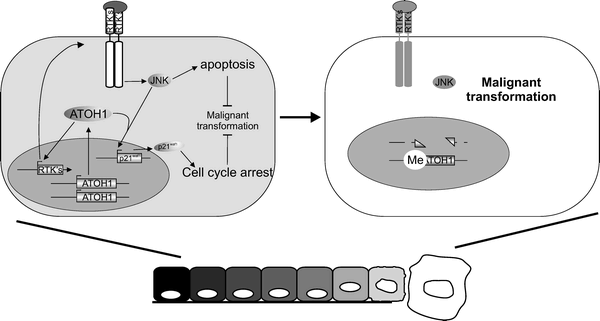All of us begin our lives as one cell, which divides into two, four, eight … into a human of a few billion cells. Almost all cells in an adult human – skin cells, liver cells, eye lens cells, nerve cells, insulin-producing cells etc – are highly specialized to perform a specific function. They are no longer capable of taking on another task: when a skin cell divides, you get more skin cells. During the growth from an embryo to an adult human, the cells become more and more specialized ("differentiated", biologists say).
Cancer cells are an exception to that rule: they are much less specialized, and feel at home in different places in the body. Researchers have long believed that cells must take the last step in their specialization to be better protected from turning into cancer cells. However, this was not proven in a living organism.

Schematic Representation of the Potential Mechanism of ATOH1′s Function as a Tumor Suppressor. In preneoplastic tissue, Atoh1 keeps malignant transformation in check in a JNK-dependent mechanism by the induction of apoptosis and the inhibition of cell cycle progression. When Atoh1 is lost due to deletion or methylation, these brakes on oncogenesis fail, and malignant transformation can progress. From: Atonal homolog 1 Is a Tumor Suppressor Gene Bossuyt W, Kazanjian A, De Geest N, Kelst SV, Hertogh GD, et al. PLoS Biology Vol. 7, No. 2, e39 doi:10.1371/journal.pbio.1000039
Wouter Bossuyt from the Group of Bassem Hassan and their fellow VIB researchers at K.U.Leuven, now demonstrate with fruit flies that master control genes steering the specialization step indeed inhibit tumor formation. The specific example the VIB scientists used, are the ones biologists call the Atonal genes. These genes are very similar to each other in all species, from flies to humans.
With mice, and in collaboration with colleagues from the United States, they showed that loss of one of those genes, Atonal homolog 1 or ATOH1, causes colon cancer. The gene regulates the last step in the specialization to epithelial cell of the colon. Humans with colon cancer frequently have an inactivated ATOH1 gene, the researchers observed.
Treatment
The researchers could – in a test tube – reactivate the gene in human colon cancer cells. The tumor cells stopped growing and committed suicide. Since they were able to switch the gene on with a reasonably simple chemical, this opens possibilities to one day perhaps switch the gene back on in living patients. It will be very important in the future to study in detail how exactly ATOH1 does performs its anti-cancer job.
Citation: Bossuyt W, Kazanjian A, De Geest N, Kelst SV, Hertogh GD, et al. (2009) Atonal homolog 1 Is a Tumor Suppressor Gene. PLoS Biol 7(2): e1000039 doi:10.1371/journal.pbio.1000039






Comments